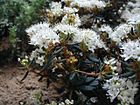Note: This is a project under development. The articles on this wiki are just being initiated and broadly incomplete. You can Help creating new pages.
Difference between revisions of "Rhododendron tomentosum - Wild rosemary"
| Line 1: | Line 1: | ||
[[File:Ledum palustre 08.JPG|thumb|right]] | [[File:Ledum palustre 08.JPG|thumb|right]] | ||
| − | '''Rhododendron tomentosum''' | + | '''Rhododendron tomentosum''' is commonly known as marsh Labrador tea, northern Labrador tea or wild rosemary. It is a flowering plant in the subsection Ledum of the large genus Rhododendron in the family Ericaceae. |
==Uses== | ==Uses== | ||
{{Uses|Asthma}}, {{Uses|Cough}}, {{Uses|Cold}}, {{Uses|Stomach aches}}, {{Uses|Kidney ailments}}, {{Uses|Burns}}, {{Uses|Ulcers}}, {{Uses|Stings}}, {{Uses|Infections}} | {{Uses|Asthma}}, {{Uses|Cough}}, {{Uses|Cold}}, {{Uses|Stomach aches}}, {{Uses|Kidney ailments}}, {{Uses|Burns}}, {{Uses|Ulcers}}, {{Uses|Stings}}, {{Uses|Infections}} | ||
| Line 8: | Line 8: | ||
==Chemical Composition== | ==Chemical Composition== | ||
| − | The main constituents of the oils were p-cymene (44.02%), linalool (20.5%), γ-terpinene (16.62%), thymol (1.81%), β-pinene (3.61%), α-pinene (2.83%) and eucalyptol (2.64%). | + | The main constituents of the oils were p-cymene (44.02%), linalool (20.5%), γ-terpinene (16.62%), thymol (1.81%), β-pinene (3.61%), α-pinene (2.83%) and eucalyptol (2.64%).<ref name="chemical composition"/> |
==Common names== | ==Common names== | ||
| Line 37: | Line 37: | ||
===Flower=== | ===Flower=== | ||
| − | {{Flower|Unisexual|2-4cm long|white|8| | + | {{Flower|Unisexual|2-4cm long|white|8|The flowers are a composition of 2-3 showy}} |
===Fruit=== | ===Fruit=== | ||
| − | {{Fruit||7–10 mm| | + | {{Fruit||7–10 mm|Clearly grooved lengthwise, Lowest hooked hairs aligned towards crown||Many}} |
===Other features=== | ===Other features=== | ||
| Line 51: | Line 51: | ||
==How to plant/cultivate== | ==How to plant/cultivate== | ||
| − | Requires a lime-free loam or peaty soil[1, 11]. Prefers a moist humus-rich acid soil in shade or semi-shade | + | Requires a lime-free loam or peaty soil[1, 11]. Prefers a moist humus-rich acid soil in shade or semi-shade.<ref name="How to plant/cultivate"/> |
==Commonly seen growing in areas== | ==Commonly seen growing in areas== | ||
| Line 70: | Line 70: | ||
<references> | <references> | ||
| − | <ref name="chemical composition">[https://www.tandfonline.com/doi/abs/10.1080/09637480701777944?src=recsys&journalCode=iijf20 | + | <ref name="chemical composition">[https://www.tandfonline.com/doi/abs/10.1080/09637480701777944?src=recsys&journalCode=iijf20 Chemical constituents]</ref> |
| − | <ref name="Leaf">[http://pza.sanbi.org/eriocephalus-africanus | + | <ref name="Leaf">[http://pza.sanbi.org/eriocephalus-africanus Plant decsription]</ref> |
| − | <ref name="How to plant/cultivate">[https://www.pfaf.org/user/Plant.aspx?LatinName=Ledum+palustre | + | <ref name="How to plant/cultivate">[https://www.pfaf.org/user/Plant.aspx?LatinName=Ledum+palustre Cultivation details]</ref> |
</references> | </references> | ||
Revision as of 14:47, 16 June 2020
Rhododendron tomentosum is commonly known as marsh Labrador tea, northern Labrador tea or wild rosemary. It is a flowering plant in the subsection Ledum of the large genus Rhododendron in the family Ericaceae.
Contents
- 1 Uses
- 2 Parts Used
- 3 Chemical Composition
- 4 Common names
- 5 Properties
- 6 Habit
- 7 Identification
- 8 List of Ayurvedic medicine in which the herb is used
- 9 Where to get the saplings
- 10 Mode of Propagation
- 11 How to plant/cultivate
- 12 Commonly seen growing in areas
- 13 Photo Gallery
- 14 References
- 15 External Links
Uses
Asthma, Cough, Cold, Stomach aches, Kidney ailments, Burns, Ulcers, Stings, Infections
Parts Used
Chemical Composition
The main constituents of the oils were p-cymene (44.02%), linalool (20.5%), γ-terpinene (16.62%), thymol (1.81%), β-pinene (3.61%), α-pinene (2.83%) and eucalyptol (2.64%).[1]
Common names
| Language | Common name |
|---|---|
| Kannada | |
| Hindi | |
| Malayalam | |
| Tamil | |
| Telugu | |
| Marathi | NA |
| Gujarathi | NA |
| Punjabi | NA |
| Kashmiri | NA |
| Sanskrit | |
| English | Agrimony |
Properties
Reference: Dravya - Substance, Rasa - Taste, Guna - Qualities, Veerya - Potency, Vipaka - Post-digesion effect, Karma - Pharmacological activity, Prabhava - Therepeutics.
Dravya
Rasa
Tikta (Bitter), Kashaya (Astringent)
Guna
Laghu (Light), Ruksha (Dry), Tikshna (Sharp)
Veerya
Ushna (Hot)
Vipaka
Katu (Pungent)
Karma
Kapha, Vata
Prabhava
Habit
Identification
Leaf
| Kind | Shape | Feature |
|---|---|---|
| Simple | Needle-shaped | The small, needle-shaped leaves are another adaptation that limits water loss |
Flower
| Type | Size | Color and composition | Stamen | More information |
|---|---|---|---|---|
| Unisexual | 2-4cm long | white | 8 | The flowers are a composition of 2-3 showy |
Fruit
| Type | Size | Mass | Appearance | Seeds | More information |
|---|---|---|---|---|---|
| 7–10 mm | Clearly grooved lengthwise, Lowest hooked hairs aligned towards crown | Many | {{{6}}} |
Other features
List of Ayurvedic medicine in which the herb is used
Where to get the saplings
Mode of Propagation
How to plant/cultivate
Requires a lime-free loam or peaty soil[1, 11]. Prefers a moist humus-rich acid soil in shade or semi-shade.[3]
Commonly seen growing in areas
Tall grasslands, Bridge of Allan in Sterling and Perth.
Photo Gallery
References
External Links
- Ayurvedic Herbs known to be helpful to treat Asthma
- Ayurvedic Herbs known to be helpful to treat Cough
- Ayurvedic Herbs known to be helpful to treat Cold
- Ayurvedic Herbs known to be helpful to treat Stomach aches
- Ayurvedic Herbs known to be helpful to treat Kidney ailments
- Ayurvedic Herbs known to be helpful to treat Burns
- Ayurvedic Herbs known to be helpful to treat Ulcers
- Ayurvedic Herbs known to be helpful to treat Stings
- Ayurvedic Herbs known to be helpful to treat Infections
- Herbs with Leaves used in medicine
- Herbs with common name in English
- Habit - Herb
- Index of Plants which can be propagated by Seeds
- Index of Plants which can be propagated by Cuttings
- Herbs that are commonly seen in the region of Tall grasslands
- Herbs that are commonly seen in the region of Bridge of Allan in Sterling and Perth
- Herbs
- Ayurvedic herbs that don't have seed photos
- Ericaceae







